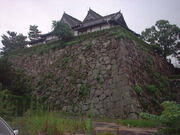
Iliathar Strait (Standard Gao-Showa: 春田市, Haruta-shi), is the main city on the island of "Little Artania" in the Bailon archipelago, which is under the jurisdiction of the federal government of Beluzia. Little Artania is the southernmost and smallest main island of the Bailonese archipelago. Originally built by the first wave of Gao-Showa refugee after the fall of the Empire of Gao-Soto, it is one of the oldest settlements in Bailon.
Iliathar Strait is famous for almost entirely built on a flood plain, where multiple rivers from the middle of the island converge and flow into the ocean. Because of that, it has been a major agriculture and fishing centre of Bailon since its construction. It is also famous for its extensive irrigation canal through the city, as well as the Haruta Castle at the centre of the city.
Because of its strategic location between Bailon and mainland Beluzia, Iliathar Strait is also a prospering local commercial hub. That, combined with the lack of mineral resources on the island, as well as strict environmental protection policy, means Iliathar Strait is one of the few cities in Beluzia that is not dominated by industrial activity.
The main shrine of Takanashi Clan is also located in the vicinity of Iliathar Strait.
Points of Interest[]
Haruta Castle[]

Parts of the outer wall of Haruta "sunken castle", named after its lack of stone foundation, and the design that can flood the outer courtyard during invasion.
Located at the centre of Iliathar Strait, the Haruta Castle (Standard Gao-Showa: 春田城, Haruta-shiro) is believed to be one of the oldest permanent structure of the city. Built by the first wave of Kunihito colonists during the 15th century to defend the field from outsiders, it was considered the de facto capital of New Dovani and its loose confederation of villages and city-states, as well as the home castle of the Haruta warrior clan.
With itself at the centre of the flood plain where the modern city is built upon, the irrigation canal system means the castle is at a highly-defensible location even if it was not built on a hill. Not only did the marsh-like fields made heavily-armoured warriors and siege engines very difficult to approach the castle, the outer courtyard is deliberately built below sea level, so that the canals will easily flood it to further isolate the castle proper from invaders.
Although the Haruta Clan was formed by warrior followers of Kiyomism, the clan itself initially reject the secular authority of Takanashi Clan, and has resisted numerous attacks from Takanashi-allied factions. It was not until the advent of gunpowder-based weapons did the castle become vulnerable, and it still toke a bloody assault until an infiltration gained control on the flooding canal, and threaten to use it against the castle, did it surrender to Takanashi Clan. Seeing that the power of Haruta Clan was stll strong, they were not deposed of power, and was allowed to keep their land as long as the high water priestess was recognised as their ultimate ruler.
The Haruta Castle remains as private property of Haruta Clan, but has opened up most parts of it for tourists. The original Haruta arsenal, producer of the 6.5x50mm Haruta cartridge, is also located inside the castle complex.
